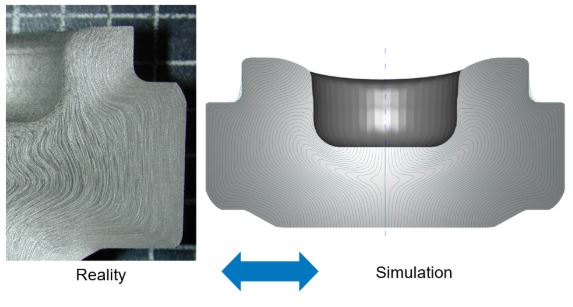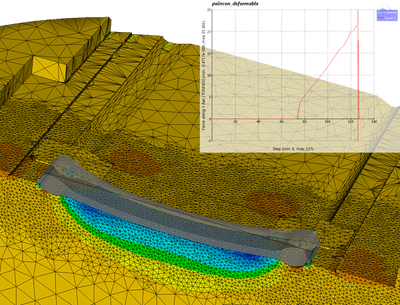In multiple manufacturing sectors, the challenge is to respond to the market as quickly as possible while reliably producing components and generating an operating margin. How do companies succeed in meeting this challenge?
Guarantee the quality by anticipating manufacturing defects
Whatever the forming process, numerical simulation helps detecting defects upstream of the production. This is the case in casting processes with the detection of internal porosities and element segregations of alloys, in forging processes with the detection of folds or cracks and in plastic injection with the prediction of weld lines.
The performance of components also depends on characteristics induced by the process itself such as the wrought which will influence the presence of inclusions or on the orientation of the fiber, ensuring good performance mechanical.
 Fibering a forged part: reality vs. simulation
Fibering a forged part: reality vs. simulation
For sensitive sectors such as aeronautics or nuclear, the performance of parts also passes by mastering their metallurgical characteristics. Our software makes it possible to model the phenomena of phase transformations, grain growth and recrystallization. This is essential in the manufacturing of alpha-beta biphasic titanium alloy parts or to obtain monocrystalline dawn.
To get most out of these multiple advantages, you can engage in a ‘First Time Right’ approach with the ability to anticipate possible serious faults of result. You limit trial and error as well as pre-production phases and you reduce your associated costs in control of non-destructive testing.
Based on customer feedback from the automotive industry; the simulation reduced by 70% trial and error and obtained ‘good the 1st try’ parts in more than 90% of cases.
Act to reduce the costs of production
The production cost of components is in the first place dependant on the costs associated with the material involved and the simulation helps to effectively enhance the yield improvement. But it is also necessary to consider the costs associated with the design and manufacturing of molds or tools. Depending on the complexity, the cost unit of an injection mold can be greater than 100,000 euros and the cost of a forge tool can represent up to 15% of the total cost of the part.
It is therefore important that the simulation is an essential asset to accelerate the design phase and increase the service life of tools. The die calculation makes it possible to analyze the stresses causing mechanical cracking and predict areas highly subject to abrasive or thermal wear phenomena. This approach also applies in the foundry sector to prevent breakage sand cores.

“ Implementing the COLDFORM® software helped us lower our stamping die design and manufacturing costs by reducing the amount of tools in our stamping process. Thanks to the software’s upstream analysis and simulation, the stamp maker can now directly compare theory with practice during stamping chain design, which makes it possible to avoid any deviation of our process and translates to major time savings. We were also able to extend the life of our stamping tools (punches, cores, matrices, etc.) by reducing the amount of breakage, by better distributing the stresses on our tools.”
Benoit PES, Head of Stamping and Mechanics and André CHAVES, Expert Stamp Maker, Boucledor - Switzerland


